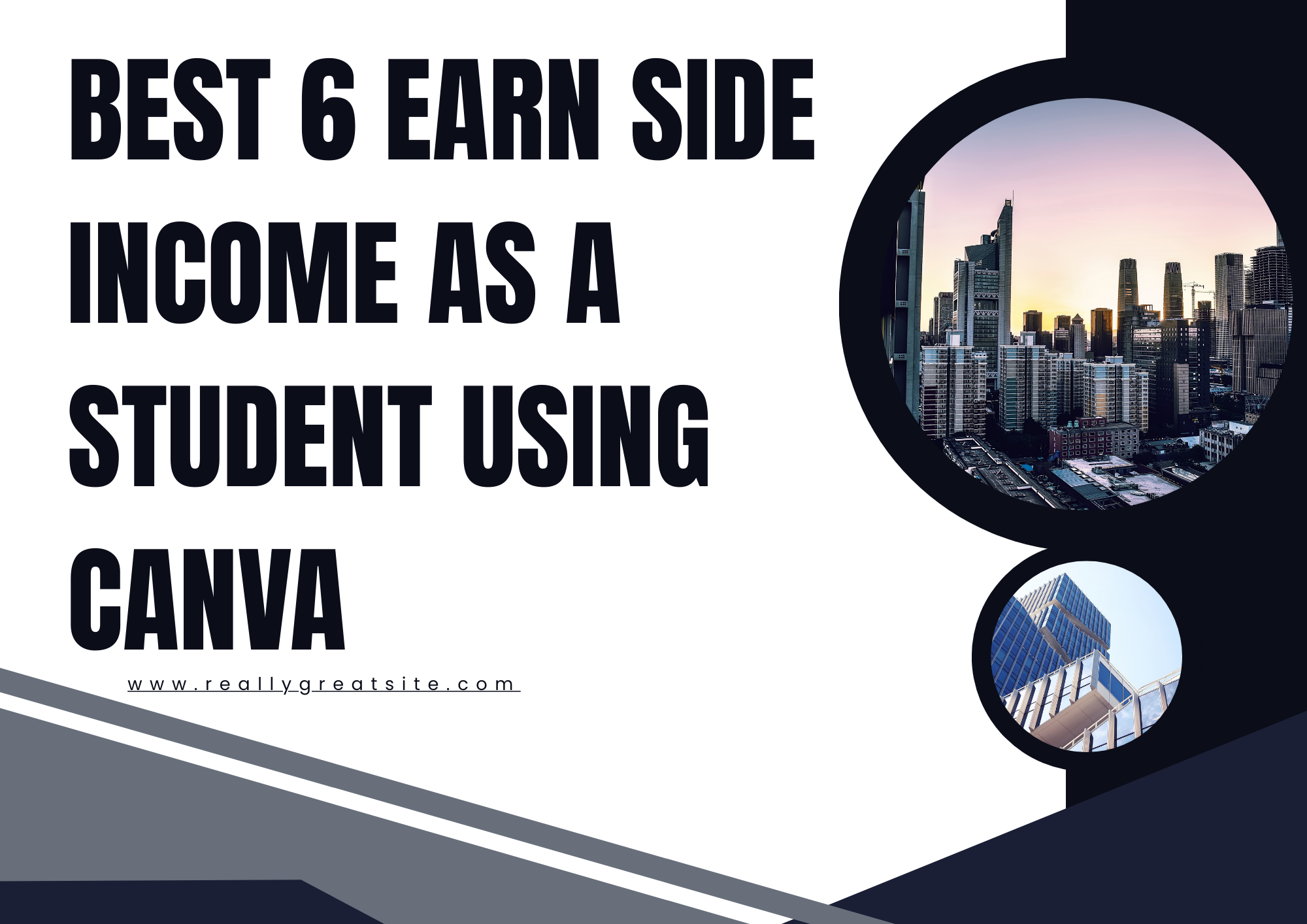10 Best Ways Use Canva to Earn Side Income
Introduction: Why Students Should Use Canva to Earn Side Income
Students today live in an age where opportunities to earn money are just a few clicks away. Unlike the past, when young people had to wait until graduation to start working, today’s digital tools make it possible to create a reliable side income while still studying. One of the most popular and beginner-friendly tools that students can use to kickstart their online journey is Canva.
So, what exactly is Canva? It’s a powerful online design platform that allows anyone—even complete beginners—to create professional graphics without advanced skills. With Canva, you can design everything from social media posts, business cards, resumes, and presentations to eBooks, invitations, and even YouTube thumbnails.
Now here’s where it gets exciting: Canva is not just for academic projects or classroom presentations. Students can actually turn their Canva skills into a money-making side hustle. Whether it’s freelancing for clients, creating and selling digital templates, or offering design services for businesses, Canva opens the door to countless ways of earning income online.
Imagine This Scenario
Picture yourself as a university student with little free time, no expensive design software, and zero advanced technical skills. Learning Photoshop or Illustrator feels overwhelming, and you don’t have the budget for premium tools. You don’t have to worry about any of that when using Canva.
In just minutes, you can create a polished resume for a classmate, a professional-looking Instagram post for a small business, or a YouTube thumbnail for a content creator. People are willing to pay for these services because not everyone has the time or creativity to design. This means you can start building your freelance career right from your laptop, without leaving your dorm room.
Why Canva is Perfect for Students
Let’s break down why Canva is such a great option for students looking to earn side income:
1. Free to Start
Most students don’t have the budget for expensive design tools. The free version of Canva provides thousands of ready-to-use templates, fonts, and design elements, giving you everything you need to start working with clients. Later, if you want advanced features like brand kits and premium stock content, you can upgrade to Canva Pro.
2. No Experience Required
The drag-and-drop design feature makes Canva incredibly beginner-friendly. Even if you’ve never designed anything before, you can learn quickly. Canva makes it simple to adjust text, images, shapes, and colors to create professional designs in minutes.
3. Huge Market Demand
The demand for design is massive. Every business, content creator, startup, and influencer needs high-quality visuals. From social media graphics to pitch decks, Canva gives you the tools to create what people are already looking for.
4. Flexible Side Hustle
Unlike traditional part-time jobs that require fixed schedules, Canva allows you to work on your own time. You can design during weekends, evenings, or study breaks. This makes it the perfect side hustle for busy students.
5. Multiple Income Streams
Canva is not just about one way of earning money. Students can:
Offer freelance services on Fiverr or Upwork.
Create and sell items like planners, templates, or worksheets on Etsy
Create social media content packages for small businesses.
Join the Canva affiliate program to earn commissions.
Even teach Canva skills through workshops or YouTube tutorials.
Canva isn’t only about creating designs; it opens doors to real financial freedom.
What You’ll Learn in This Guide
In this article, we’ll take you step by step through everything you need to know about making money with Canva as a student. Here’s what we’ll cover:
Step 1: Learning the Basics of Canva – Getting comfortable with the platform and its features.
Step 2: Monetization Strategies – Different ways to earn money using Canva (freelancing, selling templates, social media services, affiliate marketing, etc.).
Step 3: Tool Tutorials – Practical breakdowns of Canva’s features for real-world projects.
Step 4: Comparisons and Tips – Which methods are best for beginners vs. advanced users.
Step 5: FAQs and Bonus Tips – Extra advice, mistakes to avoid, and answers to common questions.
By the end, you’ll have a clear roadmap to start earning money with Canva, even if you’re a beginner.
Step 1: Learn the Basics of Canva
Make sure you master Canva’s essential features before jumping into monetization. Luckily, Canva is designed to be student-friendly, so you can learn as you go.
Key Features of Canva for Students
Templates → Thousands of ready-made designs for resumes, Instagram posts, presentations, YouTube thumbnails, and more.
Drag-and-drop editor →Move text, pictures, icons, and shapes around in seconds.
Stock Library → Access free and premium stock photos, videos, graphics, and audio.
Collaboration Tools → Work with classmates on group projects or collaborate with clients directly in Canva.
Export Options → Download designs in multiple formats, including JPG, PNG, PDF, MP4, and GIF.
👉 Pro Tip: Start with Canva’s free plan to learn the basics. Once you’re ready to scale your services and need access to advanced features, consider upgrading to Canva Pro.
Step 2: Monetization Strategies – How Students Can Earn with Canva
Canva is not just a design tool; it’s a money-making platform for students who want to build a flexible side hustle. With creativity, consistency, and a little strategy, you can turn Canva into a source of extra income. Below are practical, step-by-step ways students can earn with Canva, along with examples and platforms to get started.
1. Freelancing on Platforms (Fiverr, Upwork, Freelancer)
One of the fastest ways to make money with Canva is through freelancing. As a student, you can offer design services such as:
Social media posts for businesses and influencers.
Professional resumes and CVs for job seekers.
Business cards and flyers for local companies.
Presentations for startups, entrepreneurs, or corporate teams.
For example, you could offer a “10 Instagram Posts Package” for around $50. Small businesses and content creators are often willing to pay for ready-to-use designs because it saves them time and effort.
👉 Where to start freelancing?
Fiverr – Great for beginners; clients search for your services.
Upwork – Best for building long-term freelance relationships.
Freelancer – Ideal for bidding on one-time projects.
💡 Pro Tip: Create a strong portfolio showcasing Canva designs. Even if you don’t have paying clients yet, design sample resumes, social media packs, and posters to display your skills.
2. Selling Digital Products on Marketplaces
If freelancing isn’t your style, consider selling digital products—a passive income method. With Canva, you can design:
Resume templates (ATS-friendly for job seekers).
Daily or weekly planners for productivity.
eBooks and workbooks for online educators.
Social media template packs for entrepreneurs.
Once you design them, you can sell these templates multiple times, creating ongoing revenue without extra effort.
👉 Popular marketplaces to sell on:
Etsy – Best for students selling digital planners, resumes, or aesthetic templates.
Creative Market is a go-to platform for professionals who need premium-quality designs
Gumroad – Perfect for selling directly to your own audience.
💡 Pro Tip: Niche down! Instead of selling generic templates, create products for specific audiences, like wedding planners, real estate Instagram packs, or teacher lesson plan templates.

3. YouTube Thumbnails and Social Media Graphics
Influencers, YouTubers, and coaches often struggle with design. They need consistent branding but don’t always have the skills or time to create visuals. That’s where you come in.
With Canva, you can offer:
YouTube thumbnails (charge $5–$10 each).
Instagram posts and stories for lifestyle influencers.
Banner designs for YouTube or Twitter.
Even creating a monthly package of 20 Instagram posts can bring in $100+ from a single client. Since content creators need fresh designs constantly, this can turn into long-term income.

4. Canva Affiliate Program
Another way to earn is through affiliate marketing. Canva has its own affiliate program where you earn a commission every time someone signs up for Canva Pro using your referral link.
This is perfect if you:
Run a blog or YouTube channel.
Have a strong social media presence.
Share design tutorials or student productivity tips.
💡 Pro Tip: Create content like “How to Make Instagram Posts with Canva” and include your Canva affiliate link. When users sign up for Canva Pro through your link, you earn a payout.
👉 Learn more: Canva Affiliate Program
5. Teaching Canva Workshops
If you enjoy teaching, you can earn by helping beginners learn Canva. Many people, including small business owners and fellow students, want to master Canva but don’t know where to start.
You can:
Host live Zoom workshops for local students.
Monetize your Canva skills by offering step-by-step courses on Skillshare or Udemy.
Build a YouTube channel offering Canva tips (monetize through ads and affiliate links).
💡 Pro Tip: Start small by offering free sessions, then gradually charge for advanced training.
Step 3: Tool Tutorials – How to Use Canva for Money-Making Projects
Now that you know how to monetize Canva, let’s break down the most useful Canva tools and where they fit in different income strategies.
Canva for Social Media Content (Best for Beginners)
Features:Access thousands of editable templates tailored for Instagram, TikTok, YouTube, and Facebook.
Best for: Students starting out with freelancing.
Pros: High demand, quick to create.
Cons: Market can be competitive.
👉 Example: Create a monthly Instagram content pack for small businesses.
Canva for Resume & Portfolio Design (Best for Job Seekers)
What it offers: Professional, ATS-friendly resume and CV templates.
Best for: Students who want to sell resume design services.
Pros: Every student and job seeker needs a resume.
Cons: Pricing may be lower compared to corporate design projects.
👉 Example: Offer a $30 “Resume + Cover Letter Design Package” on Fiverr.

Canva for Business Presentations (Best for Corporate Clients)
What it offers: Professional templates for PowerPoint-like presentations.
Best for: Freelancers targeting startups, consultants, or business owners.
Pros: You can charge more—companies usually pay better for quality work.
Cons: Designing a full presentation can be time-consuming.
👉 Example: Charge $100+ for a polished 20-slide business deck.
Canva for Digital Products (Best for Passive Income)
What it offers: A wide range of templates for planners, guides, eBooks, and checklists.
Best for: Students who want to sell online without ongoing client work.
Pros: Create once, sell many times.
Cons: Success depends on marketing and finding the right niche.
👉 Example: Design a “Student Planner Template” and sell it for $10 on Etsy.
Step 4: Comparison Table – Canva Monetization Options
To help you choose the right income path, here’s a quick comparison of different monetization strategies:
| Method | Best For | Income Potential | Difficulty Level | Platform |
|---|---|---|---|---|
| Freelancing | Beginners | $50–$500/month | Medium | Fiverr, Upwork |
| Selling Templates | Passive Income Seekers | $100–$1000/month | Medium | Etsy, Gumroad |
| Social Media Graphics | Quick Jobs | $5–$20 per design | Easy | Fiverr, Instagram |
| Affiliate Program | Bloggers/Influencers | $50–$300/month | Easy | Canva Affiliate Program |
| Teaching Canva | Long-Term Growth | $200–$1000/month | Hard | Udemy, YouTube, Zoom |
Step 5: Bonus Tips for Students Using Canva to Earn Money
By now, you’ve learned how Canva can be used to create designs, sell templates, freelance, and even build passive income streams. But before you jump in, there are some important best practices and common mistakes you should know. These tips will help you stand out, avoid beginner pitfalls, and maximize your earning potential.
✅ Best Practices for Students Using Canva
Build a Portfolio of Your Canva Work
Clients and customers need proof of your skills before they pay you. Start with a simple portfolio highlighting a variety of designs you’ve created in Canva.Social media posts
Business cards
Resumes
eBook covers
YouTube thumbnails
Even if they’re sample projects, showcasing your abilities makes you look professional and trustworthy.
Offer Bundles Instead of One-Off Designs
Selling one design at a time often limits your income. Instead, package your services. For example:“30 Instagram Posts for $100”
“10 YouTube Thumbnails for $70”
For $50, you’ll receive a polished resume, cover letter, and LinkedIn banner.
Bundles give more value to clients and increase your earnings per project.
Use Free Tools to Improve Your Designs
Canva makes designing easy, but combining it with other tools boosts quality. For example:Grammarly → Fix grammar and spelling in your designs.
Unsplash / Pexels → Get high-quality, free stock photos.
Color Hunt → Explore trendy color palettes.
These free tools add polish to your Canva projects and make them look more professional.
❌ Common Mistakes to Avoid
Copying Canva Templates Without Editing
Canva’s pre-made templates are a great starting point, but many students make the mistake of using them as-is. Clients and platforms like Google value originality. Always customize fonts, colors, layouts, and images to create something unique.Undervaluing Your Work
Many beginners start by charging very low prices (like $5 per project). While this might help you land your first clients, don’t sell yourself short. Your time and creativity are valuable. Once you gain some experience, gradually increase your pricing.Relying on Only One Platform
If you only sell on Fiverr, or only on Etsy, you’re limiting your opportunities. Spread out your services across multiple platforms like:Fiverr for freelancing gigs
Etsy for selling templates
Showcase your work on Instagram or Pinterest to grab the attention of clients.
Diversifying increases your chances of getting clients faster.
FAQs for Students Using Canva
We’ve rounded up the most frequently asked questions from students—and answered them for you:
Q1: Can students use Canva for commercial purposes?
👉 Yes. Canva allows commercial use as long as you follow their content license terms. Always check the rules before selling or publishing your designs.
Q2: Do I need Canva Pro to start earning?
👉 No. Canva Free is powerful enough to start freelancing and creating templates. Canva Pro goes further by offering premium photos, videos, and advanced features that can speed up your workflow and give your work a professional edge.
Q3: How much can a student earn with Canva?
👉 It depends on your effort and consistency. Beginners often make $50–$200 per month, but skilled designers with multiple income streams (freelancing + selling templates + affiliate marketing) can earn $1,000 or more monthly.
Q4: Where can I sell my Canva templates?
👉 Some of the best platforms include:
Q5: Can I do Canva freelancing if I have no design experience?
👉 Absolutely! Canva is beginner-friendly. Many freelancers started with no prior design training. With practice and a little creativity, you’ll be able to deliver professional-looking work.
💡 Pro SEO Tip: Add these FAQs to your blog with FAQ Schema (via Rank Math or Yoast). This increases your chances of appearing in Google’s “People Also Ask” section, bringing in more organic traffic.
Conclusion: Turn Canva Into Your Student Side Hustle
Canva isn’t just a design app—it’s a business opportunity for students. With zero upfront cost, user-friendly tools, and high demand for creative designs, it’s one of the easiest ways for students to earn money online.
Whether you decide to freelance, sell templates, design social media content, join Canva’s affiliate program, or even teach Canva workshops, there’s a method that fits your schedule and skill level.
💡 Final Advice: Start small, focus on one method, build your portfolio, and gradually scale your services. With dedication, Canva can help you build a steady stream of income while still focusing on your studies.
🔥 Now it’s your turn:
👉 Which Canva income method will you try first—freelancing, selling templates, or affiliate marketing? Share your thoughts in the comments below!

Pingback: Top AI Tools To Make Money Online In 2026 - Sociallif.com
Pingback: Canva Vs Adobe Which One Is Best In 2026 - Sociallif.com
Pingback: Free Built Personal Brand On Social Media In 2026 - Sociallif.com
Pingback: Best Way To Earn From Facebook Reels In 2026 - Sociallif.com